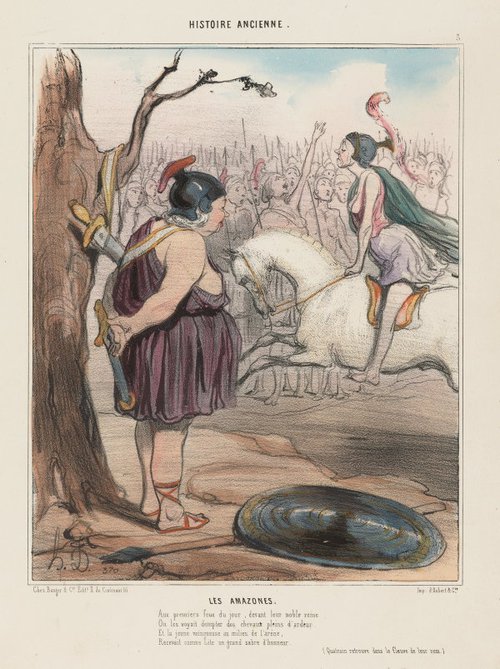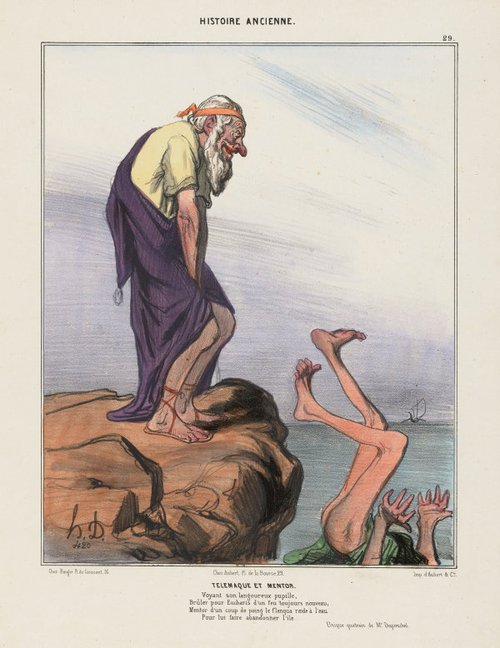-
Details
- Alternative title
- Rue Transnonain, le 15 avril 1834
- Date
- 1834
- Media category
- Materials used
- lithograph
- Edition
- only state
- Dimensions
- 28.8 x 44.5 cm image; 36.5 x 53.5 cm sheet
- Signature & date
Signed l.l., black ink [inscribed on stone] "H.-D.". Not dated.
- Credit
- Purchased with assistance from Geoff Ainsworth AM 2012
- Location
- Not on display
- Accession number
- 90.2012
- Copyright
- Artist information
-
Honoré Daumier
Works in the collection
- Share
-
-
About
Plate 24 published in 'L'Association mensuelle', July 1834.
Daumier was a talented painter and sculptor but his fame ultimately rests on his prodigious output of some 4000 quick-witted caricatures produced between 1830 and 1872, a period spanning momentous political and social upheaval in France. Daumier set the standard for graphic satire, and it is with him and his contemporaries that lithography entered the realm of journalism, bringing the printed image to middle-class audiences with greater frequency and in larger numbers than ever before.
Daumier reached the height of his popularity in the 1830s after he began working for Charles Philipon’s republican- sympathising newspapers. The energetic and entrepreneurial Philipon brought together a new generation of journalists and artists who were staunch opponents of the restored Bourbon king Charles X, and then turned on the regime of Louis-Philippe, waging a war against it in the popular press. Louis-Philippe rose to power following the July Revolution of 1830 and the deposition of Charles X. However, it soon became clear to liberals that the new government (the July Monarchy) was corrupt and that the political freedoms and social reforms it had promised would be betrayed.
In 1830 Philipon founded La Caricature, a weekly paper specialising in political satire. It came out every Thursday and usually consisted of four pages of text with printed inserts: either two one-page lithographs or one folded double-page lithograph that could be removed and framed. Philipon understood that a picture speaks louder than words: he created the enduring image of Louis-Philippe as a pear, alluding to the Citizen King’s jowly face and corpulent figure, and to the double meaning of the French word poire, signifying both ‘pear’ and ‘imbecile’. Philipon’s illustrators took up the motif and Daumier used it repeatedly.
Due to more restrictive press laws, French artists did not enjoy the same political freedoms as their British counterparts. Thus Daumier found himself arrested and serving a six-month prison sentence in 1832 for his ridicule of the king. Philipon, who had also been sent to gaol as the journal’s editor and publisher, decided to establish L’Association mensuelle lithographique (a monthly print club of sorts) to help pay his crippling fines from the censor. Subscribers to the association received one large lithograph every month. Twenty-four prints were produced in total, including five by Daumier, which are considered his masterpieces.
Rue Transnonain was the final print in the Association mensuelle series and the grimmest scene that Daumier ever drew on stone. It commemorates the assassination by the National Guard of innocent citizens during uprisings in Paris in April 1834. When the army repressed the silk workers’ revolt in Lyon, unrest spread to working-class districts in
the capital. In response to gunshots from top-floor windows at number 12, rue Transnonain, troops stormed the building and opened fire, killing and wounding residents.When Daumier’s lithograph was released six months after the event, it included a commentary by Philipon:
This lithograph is horrible to behold, as horrible as the dreadful event it recounts. It shows a murdered old man, a dead woman, the corpse of a terribly wounded man lying upon the body of a poor little baby whose head is split open. It is not a satire, it is a bloody page in the history of our modern era, a page sketched by a powerful hand and inspired by a lofty imagination. In this drawing Daumier has risen to noble heights; he has created a picture that, although painted in black on a sheet of paper, will nevertheless prove of lasting value. The butchery of rue Transnonain will remain an indelible stain on those who permitted it, and the drawing here discussed will stand as a medal struck to perpetuate the memory of a victory over fourteen old men, women, and children.
Government officials immediately confiscated the stone, and impressions of the print were tracked down and destroyed. The following year Louis-Philippe’s chief censor officially outlawed political caricature.
Peter Raissis, Prints & drawings Europe 1500–1900, 2014
-
Exhibition history
Shown in 1 exhibition
European prints and drawings 1500-1900, Art Gallery of New South Wales, Sydney, 30 Aug 2014–02 Nov 2014
-
Bibliography
Referenced in 8 publications
-
Henri Béraldi, Les graveurs du XIXe siècle, Paris, 1885-1892, vol 5 pp 120-21, no 6.
-
Loys Delteil, Honoré Daumier. Le peintre graveur illustré, XIX et XX siecles, 1925-1930, vols 20-29, no 135.
-
Ségolène Le Men, Henri Loyrette and Michael Pantazzi, Daumier 1808–1879, Ottawa, 1999, pp 177-78, no 57.
-
National Gallery of Canada, Ottawa, Daumier 1808-1879, 1999, no 57.
-
Peter Raissis, Prints & drawings Europe 1500-1900, Sydney, 2014, p 130, col illus pp 2-3, 131.
-
Peter Raissis, Look, 'Early European works on paper', Sydney, Aug 2014, pp 20-23: illus p 23.
-
Charles F. Ramus, Daumier. 120 Great Lithographs, 1978, p 122, no 8.
-
Editor Unknown (Editor), Honoré Daumier 1808-1879. The Armand Hammer Collection, 1981, no 29.
-
-
Provenance
Harris Schrank Fine Prints, New York, New York/New York/United States of America, Purchased by the AGNSW from Harris Schrank Fine Prints 2012
Ruth Benedict, Washington D.C./United States of America
James H Lockhart




